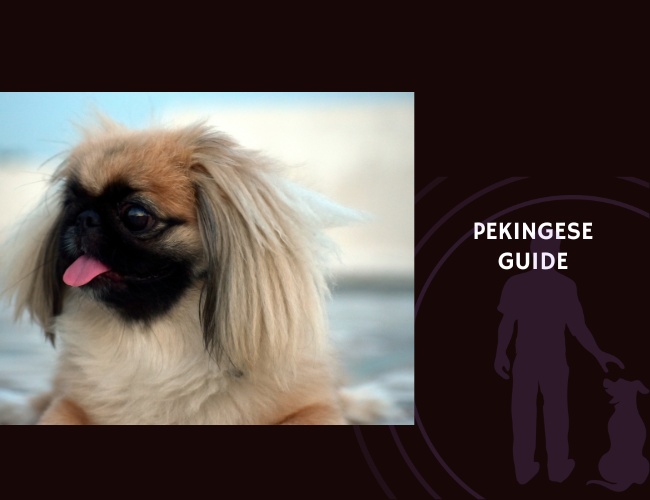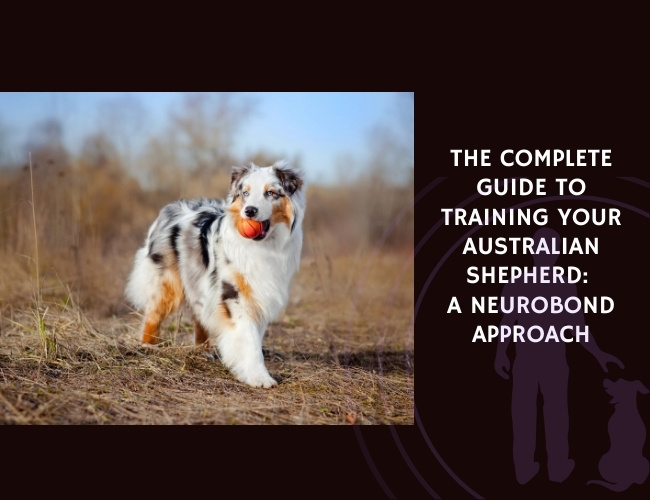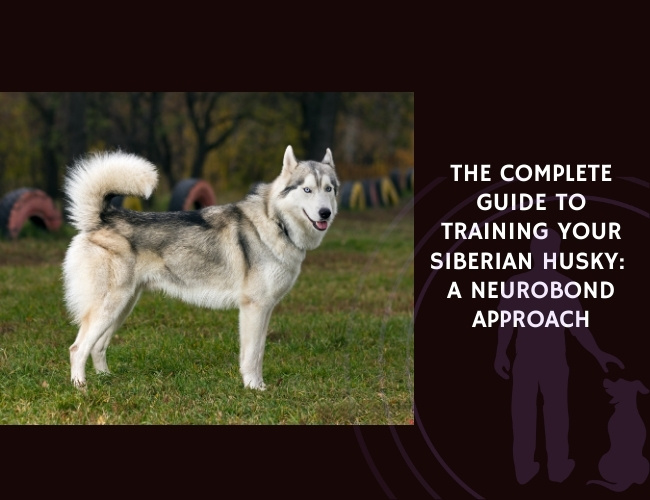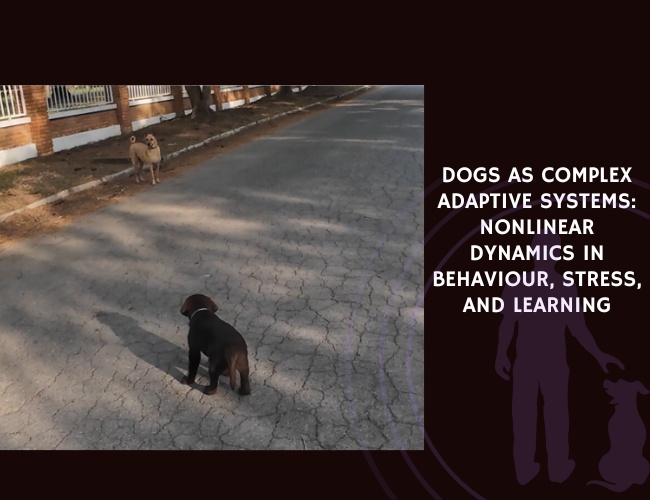Introduction: A Royal Companion with Ancient Roots
Picture a dog so treasured by Chinese emperors that stealing one was punishable by death – that’s the remarkable history behind your Pekingese companion. These diminutive “lion dogs” carry themselves with an unmistakable air of dignity, as if they somehow remember their days in the imperial palaces of ancient China. Today, while they may live in apartments rather than palaces, Pekingese dogs retain every ounce of their regal bearing and distinctive personality.
If you’re considering welcoming a Pekingese into your life, or you’re already enchanted by those large, expressive eyes and that distinctive rolling gait, let us guide you through everything you need to know about these extraordinary companions. From their unique behavioral quirks to their specific health needs, we’ll explore what makes the Pekingese one of the most distinctive breeds in the canine world.
Did you know that despite weighing only 6-14 pounds, your Pekingese likely considers themselves the guardian of your entire household? This fascinating contradiction between size and spirit defines much of what makes these dogs so special – and why they require such specific care and understanding.
Character & Behavior: Understanding Your Pekingese’s Royal Nature
The Art of Selective Bonding
Your Pekingese’s approach to relationships might surprise you. Unlike the instant friendliness of a Golden Retriever, these imperial dogs practice what we call “selective bonding” – and there’s fascinating science behind this behavior. Research shows that Pekingese typically form intense, almost exclusive bonds with one or two primary caregivers while maintaining a polite but reserved distance from others.
This isn’t coldness – it’s actually a sign of their deep emotional intelligence. Your Pekingese is essentially asking, “Have you earned my trust?” When they do grant that trust, the bond becomes unshakeable. You might notice your furry friend following you from room to room, always positioning themselves where they can keep a watchful eye on their chosen person.
Signs your Pekingese has bonded with you:
- They seek physical contact, often resting against your leg or feet
- Their entire demeanor changes when you enter the room – ears perk, tail movement increases
- They show visible distress when you prepare to leave
- They offer you their prized toys or treats
Territorial Instincts: The Palace Guard Lives On
Despite their small stature, Pekingese possess the heart of a palace sentinel. These alert little watchdogs will sound an alarm bark much bigger than their size suggests – and this isn’t just noise. Your Pekingese is fulfilling their ancestral duty as guardian of the imperial chambers.
This territorial nature manifests in several ways:
Resource Guarding: Your Pekingese might zealously protect their food bowl, favorite toys, or even their preferred spot on the sofa. This behavior stems from centuries of being valued possessions themselves – they learned to protect what was theirs.
Spatial Awareness: Notice how your Pekingese often positions themselves in doorways or at vantage points? They’re literally keeping watch, monitoring who comes and goes in their domain.
Bold Confrontations: Don’t be surprised if your 10-pound lion dog attempts to face down a German Shepherd. In their mind, they’re still the emperor’s guardian, and size is merely a detail.
Emotional Intelligence and Stress Response
Your Pekingese experiences and expresses emotions in ways that might seem almost human-like. Their emotional self-regulation patterns are unique among toy breeds, showing a sophisticated range of responses to stress and stimulation.
When overwhelmed, your Pekingese might display what we call the “imperial freeze” – becoming completely still as they process the situation. This isn’t stubbornness; it’s actually a highly evolved coping mechanism. Other stress signals include:
- Withdrawal to safe spaces: They’ll seek out their favorite hiding spot
- Low-frequency vocalizations: Those distinctive grumbles and growls communicate discomfort
- Displacement behaviors: Excessive grooming or sudden interest in their toys
Understanding these signals helps you support your companion through challenging moments. Remember, your Pekingese’s emotional world is as complex as their royal heritage suggests 🧡
Communication: Decoding the Pekingese Language
Those snores, snuffles, and grunts that make your Pekingese sound like a tiny dragon? They’re actually a sophisticated communication system. Due to their brachycephalic (flat-faced) structure, Pekingese have developed unique ways to express themselves.
The Pekingese Vocabulary:
- Low growls: “I’m setting a boundary here”
- Grunting during petting: “This is pleasant, continue”
- Sharp, purposeful barks: “Attention required immediately”
- Snuffling sighs: “I’m content but slightly inconvenienced”
Your Pekingese also masters the art of silent communication. That intense stare isn’t just adorable – they’re literally willing you to understand their needs. Watch for the subtle head tilts, ear positions, and that expressive tail that rarely wags with abandon but communicates volumes through small movements.
Training & Education: Working with Your Pekingese’s Independent Mind
Understanding “Stubbornness” – It’s More Complex Than You Think
Let’s address the elephant in the room – or should we say, the lion dog on the sofa? Pekingese have a reputation for being stubborn, but recent research reveals a more nuanced picture. What we often label as stubbornness actually breaks down into two distinct behaviors:
True Independence (60% of cases): Your Pekingese has heard your command, understood it perfectly, and is now conducting a cost-benefit analysis. “Is complying with this request worth interrupting my current activity?” This isn’t defiance – it’s autonomy.
Sensory Overwhelm (40% of cases): Sometimes what looks like ignoring you is actually your Pekingese experiencing sensory overload. Their unique facial structure can make processing multiple stimuli challenging, leading to what appears to be stubborn behavior but is actually a processing delay.
Understanding this distinction transforms your training approach. Instead of repetition or frustration, you’ll learn to read which response you’re seeing and adjust accordingly.
The Motivation Hierarchy: What Really Drives Your Pekingese
Forget everything you know about training other breeds – your Pekingese operates on their own motivational system. Research reveals a fascinating hierarchy:
1. Autonomy (45%): The power of choice reigns supreme. Your Pekingese responds best when they believe compliance was their idea. Try this: instead of commanding “sit,” create situations where sitting naturally benefits them.
2. Food Rewards (35%): But not just any treats. Your Pekingese has discerning taste. High-value rewards might include:
- Freeze-dried liver pieces
- Small bits of cheese
- Tiny portions of cooked chicken
3. Praise and Affection (20%): This varies dramatically based on your bond strength. A Pekingese who deeply trusts you might work for a gentle “good dog,” while others remain unmoved by verbal praise alone.

Training Strategies That Actually Work
The 5-Minute Rule: Your Pekingese’s attention span isn’t short – it’s selective. Keep training sessions to 5-10 minutes maximum. Think quality over quantity. Three focused 5-minute sessions throughout the day yield better results than one 20-minute marathon.
The Processing Pause: Remember that 3-5 second processing delay we mentioned? Build it into your training:
- Give the command clearly
- Wait silently for 5 seconds
- If no response, use a gentle hand signal
- Reward any movement toward compliance
Environmental Consistency: Your Pekingese needs 5-7 repetitions in different locations before they truly generalize a command. That “sit” they perfected in your kitchen? They genuinely might not understand it applies in the park too.
Touch Tolerance and Grooming Conditioning
Given their extensive grooming needs, touch tolerance training isn’t optional – it’s essential. Here’s your systematic approach:
Week 1-2: Brief, positive touches to ears during calm moments. Pair with tiny treats.
Week 3-4: Introduce paw handling. Just hold briefly, reward, release.
Week 5-6: Gentle brushing strokes, starting with their favorite areas (usually chest and shoulders).
Week 7-8: Face and facial fold handling, crucial for their daily care needs.
Week 9-12: Full grooming simulation, including teeth inspection and nail touch.
Remember: 8-12 weeks of consistent daily practice creates a Pekingese who not only tolerates grooming but potentially enjoys it. Your future self (and groomer) will thank you 🐾
Nutritional Recommendations: Feeding Your Royal Companion
Caloric Precision for the Sedentary Aristocrat
Your Pekingese’s nutritional needs are as specific as their personality. With their naturally low activity level and imperial preference for lounging, caloric control becomes crucial. An adult Pekingese typically thrives on about 1/2 to 1 cup of dry food per day, but let’s get more precise.
Daily Caloric Guidelines:
- Active Adult (10 lbs): 350-400 calories
- Typical Adult (10 lbs): 300-350 calories
- Senior Companion (8+ years): 250-300 calories
- Growing Puppy: 55-60 calories per pound of body weight
These aren’t just numbers – they’re your defense against obesity, which affects over 40% of Pekingese and significantly worsens their breathing difficulties.
Macronutrient Balance: The Royal Diet Formula
Your Pekingese requires a carefully balanced diet that supports their unique physiology:
Protein (25-30%): High-quality animal proteins support their surprisingly muscular build. Look for:
- Deboned chicken or turkey as first ingredient
- Named meat meals (chicken meal, not “poultry meal”)
- Limited ingredient formulas for sensitive stomachs
Fats (15-18%): Essential for that glorious coat, but moderation is key:
- Omega-3 fatty acids for skin health
- Balanced omega-6 ratios
- Named fat sources (chicken fat, not “animal fat”)
Carbohydrates (45-50%): Complex carbs provide sustained energy:
- Sweet potatoes over corn
- Brown rice for digestibility
- Avoid excessive fillers
Portion Control: Outsmarting the Imperial Appetite
Here’s a truth every Pekingese owner discovers: your companion believes they’re starving approximately 23 hours a day. This isn’t greed – it’s poor internal satiety regulation combined with those irresistible pleading eyes.
Successful Portion Strategies:
Measured Meals: Use a kitchen scale, not a measuring cup. Kibble density varies, but weight doesn’t lie.
Slow-Feed Solutions: Transform their 30-second gobble into a 5-minute experience:
- Puzzle feeders engage their mind
- Slow-feed bowls prevent gulping
- Scatter feeding turns mealtime into enrichment
Treat Mathematics: Those training treats add up quickly. Follow the 90/10 rule: 90% nutrition from meals, 10% from treats.
Supplementation for Optimal Health
Your Pekingese’s distinctive features require targeted nutritional support:
For That Magnificent Coat:
- Omega-3 fatty acids: 500-1000mg EPA/DHA daily
- Biotin: 2.5mg for skin health
- Zinc: 15-20mg for coat quality
For Joint Support: Even small dogs benefit from:
- Glucosamine/chondroitin combination
- Green-lipped mussel extract
- Vitamin E: 100 IU for antioxidant support
For Digestive Health: Their compressed anatomy can cause digestive issues:
- Probiotics specifically formulated for small breeds
- Digestive enzymes if recommended by your vet
- Fiber supplements for regular elimination

Dental Considerations: The Crowded Mouth Challenge
Your Pekingese’s shortened jaw creates a dental perfect storm – too many teeth in too little space. This makes dietary dental care crucial:
Kibble Engineering: Size matters. Optimal kibble diameter is 8-10mm – large enough to encourage chewing, small enough to manage.
Texture Balance: Too soft promotes plaque. Too hard risks tooth fracture. Look for kibble that’s firm but yields under pressure.
Dental Supplements:
- Water additives for daily plaque control
- Dental chews (supervised only due to choking risk)
- Raw carrots as natural tooth cleaners
Remember: No amount of dental food replaces regular teeth cleaning, but the right diet significantly slows plaque accumulation 🧡
Health Concerns: Protecting Your Precious Companion
Brachycephalic Obstructive Airway Syndrome (BOAS): The Primary Challenge
Let’s address the most significant health concern facing your Pekingese with the honesty and clarity you deserve. BOAS isn’t just a possibility – research indicates that 50-70% of Pekingese show clinical signs by age 3, with most having some degree of airway compromise.
Understanding BOAS in Simple Terms: Imagine breathing through a straw while someone partially covers the end – that’s daily life for many Pekingese. Their shortened facial structure creates multiple airway obstructions:
- Narrowed nostrils (stenotic nares)
- Elongated soft palate blocking the airway
- Collapsed laryngeal structures
- Narrow windpipe (hypoplastic trachea)
Recognizing the Signs:
- Noisy breathing: Those snorts aren’t always cute – stertor (snoring sounds while awake) indicates obstruction
- Exercise intolerance: Stopping frequently during walks, refusing to continue
- Heat stress: Panting excessively even in mild temperatures
- Sleep disruption: Waking gasping, preferring to sleep sitting up
- Gastrointestinal signs: Present in 97% of BOAS cases – frequent regurgitation, difficulty swallowing
Management Strategies That Make a Difference:
Weight Control: Every extra pound exponentially worsens breathing. Maintain ideal body weight religiously.
Environmental Modification:
- Keep indoor temperature below 75°F (24°C)
- Humidity below 60%
- Elevated feeding stations reduce neck strain
- Cooling mats for summer months
Activity Adaptation:
- Multiple short walks instead of long excursions
- Early morning and evening exercise only
- Always carry water
- Know locations of shaded rest spots on your routes
When Surgery Helps: For severe cases, surgical intervention can be life-changing. Procedures might include:
- Nostril widening (alar fold resection)
- Soft palate shortening
- Removal of everted laryngeal saccules
Ocular Vulnerabilities: Protecting Those Prominent Eyes
Your Pekingese’s beautiful, large eyes are unfortunately their most vulnerable feature. Those prominent orbs that give them such expressive faces also create significant risks.
Corneal Ulcers: The Hidden Danger Corneal ulcers occur when the eye’s surface becomes damaged. For Pekingese, common causes include:
- Facial hair constantly rubbing the eye surface
- Decreased ability to feel corneal pain (they don’t realize they’re damaging their eyes)
- Inability to fully close eyelids during sleep
- Low tear production leading to dry spots
Emergency Alert: Recognizing Corneal Ulcers
- Squinting or holding eye closed
- Excessive tearing
- Red or bloodshot appearance
- Pawing at the eye
- Cloudy or bluish eye surface
Corneal ulcers can perforate within 24-48 hours. This is always an emergency requiring immediate veterinary care.
Proptosis: When Eyes Literally Pop Out This terrifying condition affects 2-5% of Pekingese during their lifetime. The eye can literally luxate (pop out) from the socket due to:
- Trauma (even minor bumps)
- Excessive restraint around the neck
- Severe respiratory effort
- Overly aggressive play
Emergency Response for Proptosis:
- Do NOT panic – your calm helps your dog
- Immediately saline rinse if available
- Keep the eye moist with wet cloth
- Transport to emergency vet immediately
- Do NOT attempt to push eye back in
Regal. Alert. Undeterred.
The Pekingese carries the dignity of dynasties.
Bred to grace the laps of Chinese emperors, the Pekingese still walks with the composure of royalty. Compact yet commanding, they blend a lion-hearted temperament with deep loyalty and an uncanny awareness of their surroundings. This is a dog who does not follow – they choose.
Small frame, strong will.
Don’t be fooled by the Pekingese’s size or silky coat. These dogs possess remarkable independence and confidence. Their assertiveness can border on stubborn, but it also reflects deep self-assurance. They tend to bond closely with their humans but remain selective in social interactions. Behind that flat face lies a keen, ancient mind that assesses before it acts.

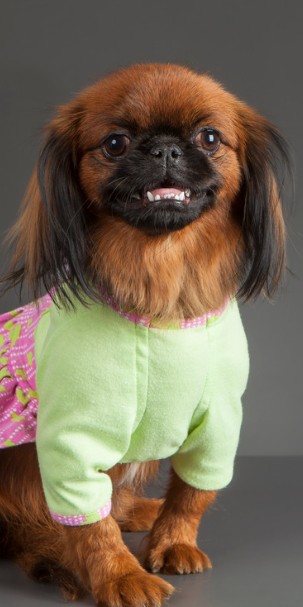
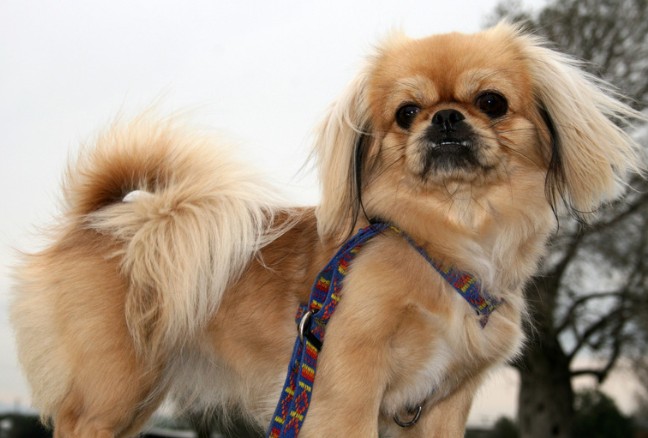
Observant, not submissive.
Pekingese are known for their watchfulness. They are less likely to bark frivolously and more inclined to monitor quietly. Their attachment is intense but rarely needy. They respect routine, prefer predictability, and demand mutual respect. Understanding their preferences builds trust and reveals the affectionate, humorous soul beneath the imperial exterior.
Intervertebral Disc Disease (IVDD): The Spine at Risk
Your Pekingese is 10.3 times more likely to develop IVDD than other breeds – second only to Dachshunds. This isn’t just a statistic; it’s a call for proactive protection.
Understanding the Risk Factors:
- Genetics: Chondrodystrophic breed status
- Weight: Each additional kilogram increases risk significantly
- Color: Black-coated Pekingese show 1.6x higher risk
- Sex: Spayed females have 1.4x increased risk
- Age: Peak incidence between 5-7 years
Early Warning Signs:
- Reluctance to jump or climb stairs
- Yelping when picked up
- Arched back or hunched posture
- Wobbling or dragging rear legs
- Loss of bladder/bowel control
Prevention Strategies:
- Maintain ideal weight religiously
- Use ramps instead of stairs
- Prevent jumping on/off furniture
- Support both front and rear when lifting
- Regular, gentle exercise to maintain muscle tone
Skin Fold Dermatitis: The Hidden Discomfort
Those adorable facial wrinkles require vigilant care. Without proper maintenance, skin fold dermatitis affects:
- 90% of facial folds
- 60% of tail pockets
- 40% of neck folds
Daily Prevention Protocol:
- Morning inspection: Check all folds for redness, odor, or discharge
- Gentle cleaning: Use veterinary-approved wipes
- Thorough drying: Moisture trapped in folds breeds bacteria
- Barrier application: Zinc oxide or prescribed creams for problem areas
When Infection Strikes:
- Foul odor from folds
- Red, inflamed skin
- Yellow or green discharge
- Dog scratching or rubbing face excessively
Treatment requires veterinary intervention with topical or systemic antibiotics. Severe cases might need surgical fold reduction.
Cardiac Considerations: The Aging Heart
While not as prevalent as in some toy breeds, cardiac disease affects a significant portion of senior Pekingese:
Age-Related Statistics:
- Congenital defects: 2-3% of puppies
- Mitral valve disease: 30% by age 10
- Heart murmurs: Often detected by age 7-8
Monitoring for Heart Disease:
- Annual cardiac auscultation after age 5
- Watch for coughing, especially at night
- Monitor exercise tolerance changes
- Note any fainting episodes
- Track respiratory rate at rest (should be under 30 breaths/minute)
Early detection through regular veterinary checkups can add years of quality life through appropriate medication and management 🐾
Attitude & Lifestyle: Creating the Perfect Pekingese Paradise
Urban Living: Where Pekingese Truly Thrive
Your Pekingese wasn’t just bred for palace life – they’re perfectly engineered for modern apartment living. With their lower energy level and minimal exercise needs, these dogs lead a lifestyle that many city dwellers can easily accommodate.
Why Pekingese Excel in Urban Settings:
Minimal Space Requirements: Your Pekingese needs about as much exercise space as a cat. A few laps around your living room can constitute meaningful activity for them.
Purposeful Barking: Unlike many small breeds, Pekingese don’t bark for entertainment. When they vocalize, there’s usually a reason – making them surprisingly good apartment neighbors.
Indoor Contentment: While some dogs pace at the door longing for adventure, your Pekingese is likely perfectly content surveying their domain from a comfortable cushion.
Schedule Flexibility: Their exercise needs (20-30 minutes daily) can be met through multiple micro-walks, perfect for busy urban schedules.
Creating Urban Comfort Zones:
- Elevated perches: Window seats or pet stairs to furniture let them survey their kingdom
- Climate control: Essential for brachycephalic comfort
- Quiet retreats: A covered bed or crate in a low-traffic area
- Easy surfaces: Minimize jumping with ramps or steps
Temperature Regulation: Your Pekingese’s Kryptonite
Let’s be crystal clear: heat is genuinely dangerous for your Pekingese. With their thick double coat and compromised breathing, they feel heat more intensely and recover more slowly than other breeds.
Critical Temperature Guidelines:
- Comfort zone: 60-70°F (15-21°C)
- Caution zone: 70-75°F (21-24°C) – limit outdoor time
- Danger zone: Above 75°F (24°C) – emergency cooling may be needed
- Humidity threshold: Above 60% significantly increases risk
Summer Survival Strategies:
Exercise Timing:
- Early morning walks before 8 AM
- Evening strolls after sunset
- Never between 10 AM – 6 PM in warm months
Cooling Arsenal:
- Cooling mats for favorite resting spots
- Frozen Kong toys for hot days
- Cooling vests for necessary outings
- Multiple water stations throughout home
Emergency Heat Stroke Protocol: Know these signs: Excessive panting, drooling, weakness, vomiting, collapse
- Move to cool area immediately
- Apply cool (not cold) water to paw pads and belly
- Offer small amounts of water
- Transport to vet immediately – heat stroke can be fatal

The Grooming Commitment: A Labor of Love
If you’re considering a Pekingese, understand this: grooming isn’t optional, it’s a daily commitment that directly impacts their health and comfort. That magnificent coat requires dedication.
Daily Requirements (20-30 minutes):
Morning Routine (10 minutes):
- Face cleaning: Remove eye discharge
- Fold inspection: Check for moisture or redness
- Quick brush: Focus on mat-prone areas
Evening Session (15-20 minutes):
- Thorough brushing: Work through entire coat
- Paw check: Remove debris between toes
- Dental care: Brushing or dental wipe
Professional Grooming Schedule:
- Every 6-8 weeks for full grooming
- Monthly nail trims (or as needed)
- Sanitary trims between full grooms
- Professional teeth cleaning annually
Essential Grooming Tools:
- Slicker brush: Daily mat prevention
- Metal comb: For detecting hidden mats
- Curved scissors: For eye area trimming
- Grooming wipes: Daily fold cleaning
- Detangling spray: Makes brushing comfortable
Remember: Regular grooming isn’t vanity – it prevents painful matting, skin infections, and helps you monitor for health issues.
Children and Pekingese: Setting Realistic Expectations
While Pekingese can live harmoniously with children, success requires careful consideration and constant supervision. They’re best suited for families with older children who understand gentle handling.
Age-Appropriate Guidelines:
Not Recommended (Under 6): Young children lack the motor control and understanding needed for safe interaction. Risk factors include:
- Dropping due to squirming
- Grabbing painful areas (eyes, ears)
- Overwhelming with affection
- Triggering defensive responses
Supervised Success (Ages 6-10): With proper education and constant supervision:
- Teach “gentle hands” before any interaction
- Demonstrate proper picking up/holding technique
- Explain the dog’s need for space
- Create “Pekingese-only” zones for retreat
Independent Interaction (10+): Mature children who can:
- Read canine body language
- Respect boundaries
- Participate in care routines
- Understand fragility concerns
Creating Safe Interactions:
- Always supervise (no exceptions)
- Teach children to sit on floor for petting
- Establish “no chase” rules
- Create separate spaces during meals
- Involve children in positive activities (gentle brushing, training)
Senior Years: Adapting to Your Aging Aristocrat
As your Pekingese enters their golden years (typically 8+), you’ll notice changes that require thoughtful adaptation. These aren’t just physical changes – your companion’s emotional and cognitive needs evolve too.
Cognitive Changes to Expect:
- Spatial confusion: Getting “lost” in familiar rooms
- Sleep disruption: Increased nighttime waking, daytime sleeping
- Selective hearing: Not defiance, but actual hearing loss
- Routine rigidity: Increased stress with changes
Supporting Cognitive Health:
- Maintain consistent routines religiously
- Provide mental stimulation through puzzle toys
- Consider cognitive support supplements (with vet guidance)
- Create visual cues for important locations (food, water, bed)
Emotional Evolution: Your senior Pekingese might become:
- More clingy, seeking constant companionship
- Or conversely, more independent and aloof
- Less tolerant of other pets or disruptions
- More vocal about needs and discomforts
Environmental Modifications:
- Night lights for navigation
- Non-slip surfaces on smooth floors
- Lower food/water dishes
- Extra padding in favorite resting spots
- Ramps to all elevated surfaces
Remember: These changes aren’t personality flaws – they’re natural aging. Your patience and adaptation help your companion navigate their senior years with dignity 🧡
Making the Decision: Is a Pekingese Right for You?
The Ideal Pekingese Guardian
After exploring every aspect of Pekingese care, let’s be honest about who thrives with these remarkable dogs. The happiest Pekingese owners share certain characteristics:
You might be perfect for a Pekingese if you:
- Value companionship over athleticism in a dog
- Work from home or have flexible schedules
- Enjoy grooming or view it as bonding time
- Live in a climate-controlled environment
- Appreciate independent thinkers
- Have patience for training challenges
- Can commit to their specific health monitoring
- Want a devoted, one-person dog
- Enjoy a quieter, more settled lifestyle
Reconsider if you:
- Want a jogging or hiking companion
- Have very young children
- Travel frequently without your pet
- Live in hot, humid climates without AC
- Expect immediate obedience
- Cannot commit to daily grooming
- Need a social butterfly dog
- Have limited funds for potential health issues
The Rewards of Pekingese Partnership
For the right owner, a Pekingese offers incomparable rewards:
Unwavering Devotion: Once you’ve earned their trust, their loyalty is absolute. You’ll never question whether you’re loved.
Endless Entertainment: Their dignity combined with playful moments creates daily amusement. Watching a Pekingese navigate their world with imperial bearing never gets old.
Peaceful Companionship: Unlike high-energy breeds, your Pekingese is content to simply exist in your presence. They’re the perfect writing companion, TV-watching buddy, or reading partner.
Emotional Intelligence: Their ability to read and respond to your moods is remarkable. Sad? They’ll offer quiet comfort. Happy? They’ll share your joy in their reserved way.
Living History: Owning a Pekingese connects you to thousands of years of history. You’re caring for a breed that once graced imperial palaces and was considered sacred.
Conclusion: Your Journey with a Lion Dog
As we’ve discovered together, the Pekingese is far more than just a pretty face or a lap warmer. These are complex, intelligent, historically significant dogs who require dedicated, informed care. From their distinctive behavioral patterns to their specific health vulnerabilities, every aspect of Pekingese ownership demands understanding and commitment.
But here’s what the statistics and medical warnings don’t capture: the profound bond between a Pekingese and their chosen person. When those expressive eyes lock onto yours, when that small body curls trustingly against you, when that distinctive little grunt acknowledges your presence – these moments make every grooming session, every careful health monitoring, every patient training attempt worthwhile.
The Pekingese asks a lot of their owners. They need your patience when they process commands on imperial time. They need your vigilance to protect them from their own anatomical vulnerabilities. They need your dedication to maintain their coat and health. They need your understanding when they assert their ancient independence.
In return, they offer something increasingly rare in our fast-paced world: the experience of being truly chosen. A Pekingese doesn’t love indiscriminately – they select their person with the same care their ancestors used to select imperial treasures. If you’re willing to meet their needs, respect their nature, and embrace both their challenges and charms, you’ll find yourself guardian to one of the dog world’s most remarkable breeds.
Is a Pekingese right for you? Only you can answer that question. But if you’ve read this far, if you’ve nodded along with the challenges while smiling at the quirks, if you’re already planning where to place those cooling mats and organizing a grooming station – then perhaps you’re ready to experience life with a lion dog.
After all, not everyone can say they share their home with canine royalty. But for those who do, life is never quite the same. Welcome to the wonderful, challenging, deeply rewarding world of Pekingese companionship. Your imperial adventure awaits 🐾🧡
Further Resources
Breed-Specific Support:
- Pekingese Club of America
- Regional Pekingese rescue organizations
- Online Pekingese owner communities
Health Resources:
- Veterinarians experienced with brachycephalic breeds
- Canine ophthalmology specialists
- Certified canine rehabilitation therapists
Training Support:
- Positive reinforcement trainers familiar with toy breeds
- Online training resources for independent breeds
- Grooming tutorials specific to Pekingese coat care
Remember: Every Pekingese is an individual. While this guide provides comprehensive information based on breed tendencies and scientific research, your particular lion dog will have their own personality, preferences, and needs. Embrace the journey of discovering what makes your Pekingese unique – it’s part of the magic of sharing your life with these extraordinary dogs.

